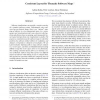Free Online Productivity Tools
i2Speak
i2Symbol
i2OCR
iTex2Img
iWeb2Print
iWeb2Shot
i2Type
iPdf2Split
iPdf2Merge
i2Bopomofo
i2Arabic
i2Style
i2Image
i2PDF
iLatex2Rtf
Sci2ools
WCRE
2008
IEEE
2008
IEEE
Consistent Layout for Thematic Software Maps
Software visualizations can provide a concise overview of a complex software system. Unfortunately, since software has no physical shape, there is no “natural” mapping of software to a two-dimensional space. As a consequence most visualizations tend to use a layout in which position and distance have no meaning, and consequently layout typical diverges from one visualization to another. We propose a consistent layout for software maps in which the position of a software artifact reflects its vocabulary, and distance corresponds to similarity of vocabulary. We use Latent Semantic Indexing (LSI) to map software artifacts to a vector space, and then use Multidimensional Scaling (MDS) to map this vector space down to two dimensions. The resulting consistent layout allows us to develop a variety of thematic software maps that express very different aspects of software while making it easy to compare them. The approach is especially suitable for comparing views of evolving software, si...
| Added | 01 Jun 2010 |
| Updated | 01 Jun 2010 |
| Type | Conference |
| Year | 2008 |
| Where | WCRE |
| Authors | Adrian Kuhn, Peter Loretan, Oscar Nierstrasz |
Comments (0)

